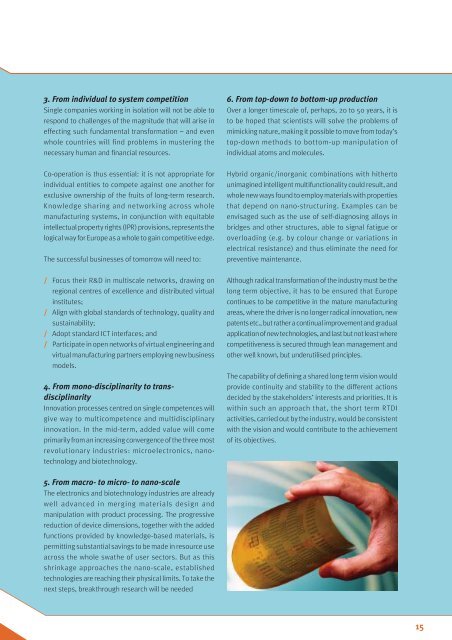MANUFUTURE – a vision for 2020
MANUFUTURE – a vision for 2020
MANUFUTURE – a vision for 2020
You also want an ePaper? Increase the reach of your titles
YUMPU automatically turns print PDFs into web optimized ePapers that Google loves.
3. From individual to system competition<br />
Single companies working in isolation will not be able to<br />
respond to challenges of the magnitude that will arise in<br />
effecting such fundamental trans<strong>for</strong>mation <strong>–</strong> and even<br />
whole countries will find problems in mustering the<br />
necessary human and financial resources.<br />
Co-operation is thus essential: it is not appropriate <strong>for</strong><br />
individual entities to compete against one another <strong>for</strong><br />
exclusive ownership of the fruits of long-term research.<br />
Knowledge sharing and networking across whole<br />
manufacturing systems, in conjunction with equitable<br />
intellectual property rights (IPR) pro<strong>vision</strong>s, represents the<br />
logical way <strong>for</strong> Europe as a whole to gain competitive edge.<br />
The successful businesses of tomorrow will need to:<br />
/ Focus their R&D in multiscale networks, drawing on<br />
regional centres of excellence and distributed virtual<br />
institutes;<br />
/ Align with global standards of technology, quality and<br />
sustainability;<br />
/ Adopt standard ICT interfaces; and<br />
/ Participate in open networks of virtual engineering and<br />
virtual manufacturing partners employing new business<br />
models.<br />
4. From mono-disciplinarity to transdisciplinarity<br />
Innovation processes centred on single competences will<br />
give way to multicompetence and multidisciplinary<br />
innovation. In the mid-term, added value will come<br />
primarily from an increasing convergence of the three most<br />
revolutionary industries: microelectronics, nanotechnology<br />
and biotechnology.<br />
5. From macro- to micro- to nano-scale<br />
The electronics and biotechnology industries are already<br />
well advanced in merging materials design and<br />
manipulation with product processing. The progressive<br />
reduction of device dimensions, together with the added<br />
functions provided by knowledge-based materials, is<br />
permitting substantial savings to be made in resource use<br />
across the whole swathe of user sectors. But as this<br />
shrinkage approaches the nano-scale, established<br />
technologies are reaching their physical limits. To take the<br />
next steps, breakthrough research will be needed<br />
6. From top-down to bottom-up production<br />
Over a longer timescale of, perhaps, 20 to 50 years, it is<br />
to be hoped that scientists will solve the problems of<br />
mimicking nature, making it possible to move from today’s<br />
top-down methods to bottom-up manipulation of<br />
individual atoms and molecules.<br />
Hybrid organic/inorganic combinations with hitherto<br />
unimagined intelligent multifunctionality could result, and<br />
whole new ways found to employ materials with properties<br />
that depend on nano-structuring. Examples can be<br />
envisaged such as the use of self-diagnosing alloys in<br />
bridges and other structures, able to signal fatigue or<br />
overloading (e.g. by colour change or variations in<br />
electrical resistance) and thus eliminate the need <strong>for</strong><br />
preventive maintenance.<br />
Although radical trans<strong>for</strong>mation of the industry must be the<br />
long term objective, it has to be ensured that Europe<br />
continues to be competitive in the mature manufacturing<br />
areas, where the driver is no longer radical innovation, new<br />
patents etc., but rather a continual improvement and gradual<br />
application of new technologies, and last but not least where<br />
competitiveness is secured through lean management and<br />
other well known, but underutilised principles.<br />
The capability of defining a shared long term <strong>vision</strong> would<br />
provide continuity and stability to the different actions<br />
decided by the stakeholders’ interests and priorities. It is<br />
within such an approach that, the short term RTDI<br />
activities, carried out by the industry, would be consistent<br />
with the <strong>vision</strong> and would contribute to the achievement<br />
of its objectives.<br />
15

















